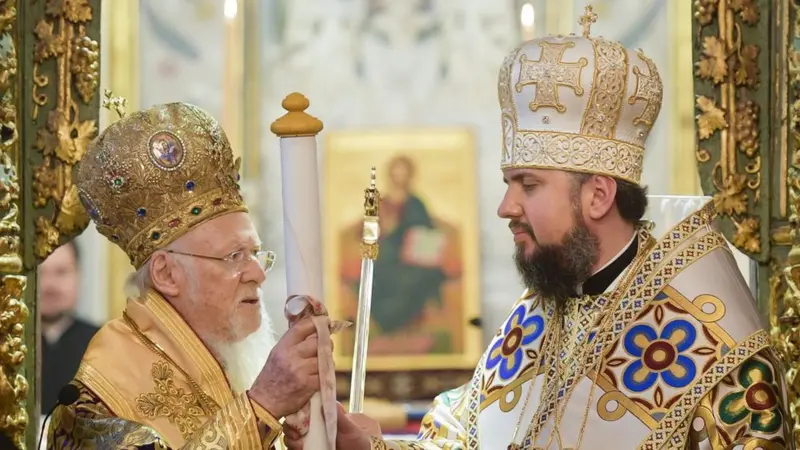
One of the many narratives from the Russian propaganda is the one about its spiritual supremacy over other countries in Eastern Europe.
But history tells a different story:
Ukrainian Christianity is historically older than Russian one, and canonically rooted in the Christian traditions. It just wants to get its rights back.
Christianity arrived in the territory of modern-day Ukraine long before Moscow was founded. In 988, Prince Volodymyr the Great baptised Kyivan Rus' in Kyiv, the major city of Eastern Slavs at the time. From Kyiv, Christianity spread north to regions where Moscow (founded only in 1147) would later emerge.
The Kyivan Metropolia was established in the 10th century and remained canonically united with the Patriarchate of Constantinople for over 700 years. It also fostered significant spiritual and cultural development in the region.
Ukraine preserves some of Eastern Europe's oldest Christian churches. St. Sophia Cathedral in Kyiv
(built in the 11th century) was and still is a symbol of Kyiv's spiritual and cultural authority. The Kyiv-Pechersk Lavra
(also founded in the 11th century) became a powerful center for monastic tradition and spiritual education. These churches prove Kyiv was a hub of Christian life long before Moscow existed.
In 1448, Moscow elected and consecrated Metropolitan Jonah to the Kyiv see without the consent of the Patriarchate of Constantinople. This was effectively the first attempt by the Moscow Church to obtain autocephaly, which, however, was not recognised by Constantinople for many decades. This act became a turning point, as Moscow separated its eparchy from the Kyiv Metropolitanate, which remained under the jurisdiction of Constantinople. TheMoscow Church remained in schism (split) for 141 years,
lacking eucharistic communion with the Orthodox world.
In 1589, Moscow obtained the patriarchate after exerting significant pressure. Negotiations with Patriarch Jeremiah II of Constantinople lasted nearly a year, and he eventually agreed to the establishment of the patriarchate - contrary to canonical tradition.
During his timein Moscow, Jeremiah II was kept under tightly controlled conditions, effectively as a prisoner. Muscovite authorities restricted his movements and kept him in isolation. His approval of the Moscow Patriarchate and the decree proclaiming Moscow as the "Third Rome" was likely drafted by the Muscovite side and signed under pressure. (see more: Plokhy, Serhii. Lost Kingdom: The Quest for Empire and the Making of the Russian Nation)
On January 23, 1589, Jeremiah formally appointed and on January 26, consecrated Metropolitan Job as the first patriarch of Moscow.
Although the Constantinople Council in May 1590 recognised the right of Moscow bishops to collectively elect a patriarch, Jeremiah II's unilateral actions were deemed improper. It is important to note that the canonical territory of the Moscow Church was recognised only as that over which its authority extended at the time of recognition, meaning, without the Kyiv Metropolitanate.
The transfer of the Kyivan Metropolia to the Moscow Patriarchate in 1686 was uncanonical and limited. This decision was made under significant political pressure and financial influence from Moscow and never held full canonical legitimacy. Also, this act did not fully transfer the Kyivan Metropolia to Moscow's jurisdiction, in reality, it only granted the Moscow Patriarch the right to ordain the Kyivan Metropolitan, while preserving all older rights under Constantinople.
However, Moscow disregarded these conditions, leading to a de facto uncanonical subordination.
In 2018, Ecumenical Patriarch Bartholomew I officially revoked this act, confirming its uncanonical nature and restoring Constantinople's direct jurisdiction over the Kyivan Metropolia before giving Tomos to the Orthodox Church of Ukraine (OCU).

In the 18th century, Russian Emperor Peter I replaced the patriarchate with the Holy Synod, effectively integrating the church into the state apparatus.The Synod functioned as a state body with a secular prosecutor, controlled by the emperor.
In the 20th century, after suppressing the Christian religion in the Soviet Union, Joseph Stalin revived the Russian Orthodox Church (ROC) as a tightly controlled structure under Soviet special services
(NKVD/KGB oversight), allowing the state to instrumentalise the church for its own ends.
The current Patriarch Kirill (Vladimir Gundyaev), reportedly a former KGB agent, openly supports the war against Ukraine. He calls the invasion a "holy war," justifies the annexation of Ukrainian territories and merges war with religion. (Institute for the Study of War)
Patriarch Kirill has faced international sanctions (from the UK, Canada, Australia, the Czech Republic and Ukraine) for his active support of aggression against Ukraine. He is also banned from entering Lithuania.
Russia's actions during the full-scale invasion of Ukraine contradict the fundamental principles of Christianity.
The Russian Orthodox Church blesses the war, ignores the Russian army's crimes and glorifies occupiers as "martyrs" embarking on a "holy war." This directly contradicts Christian commandments of peace, mercy and "Thou shalt not kill".
Russia commits genocide against Ukrainian population, abducting thousands of Ukrainian children, shelling and destroying churches and religious buildings in Ukraine. Such actions as murder, abduction and hatred contradict the very spirit of Christianity, which is based on mercy, repentance, forgiveness and love for one's neighbour.
There are significant differences not only between two nations but also between the OCU and the ROC.
Kyiv traces a thousand-year canonical lineage from Constantinople.
The Moscow Patriarchate was founded centuries later and emerged under political pressure, without full canonical legitimacy. Over time, it became closely aligned with imperial ambitions and state power.
Support the UkraineWorld team.
UkraineWorld_Editorial
This publication was compiled with the support of the International Renaissance Foundation. It's content is the exclusive responsibility of the authors and does not necessarily reflect the views of the International Renaissance Foundation.
